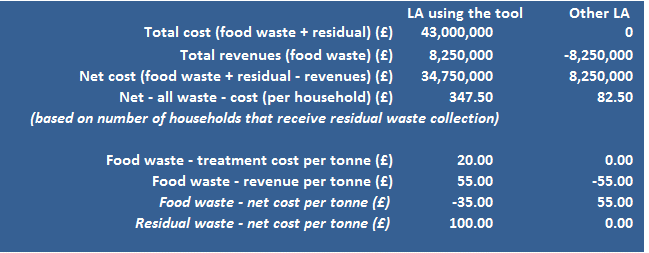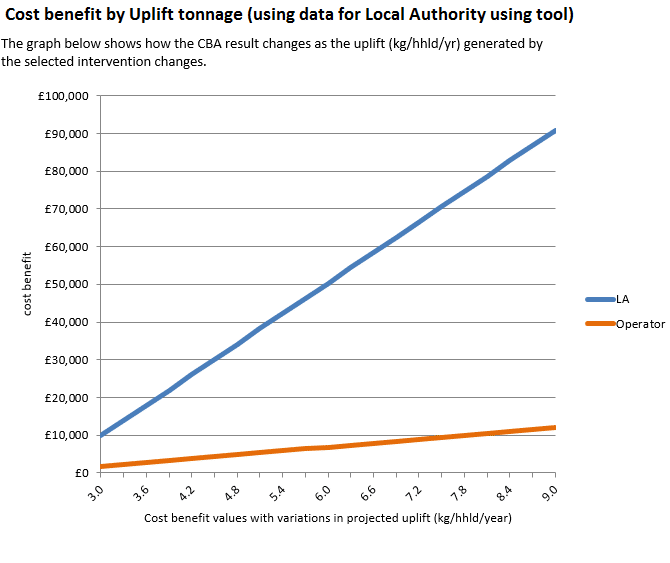The International Energy Agency recently issued its second Outlook for Biogas and Biomethane. It concluded…
Give it a try – Cost Benefit Analysis Tool for food waste recycling
What is the Cost Benefit Analysis tool?
WRAP’s Cost Benefit Analysis (CBA) tool for the food waste recycling industry, published in March 2017, is a tool designed for local authorities (LAs) who provide a separate weekly household food waste collection, and anaerobic digestion (AD) operators that process the waste.
It can be downloaded for free by clicking here and filling in your details.
It has been created to enable LAs and AD operators to examine how the potential costs and benefits of implementing intervention measures can be shared via specified contract mechanisms.
These interventions can be practical, low cost ones:
- Residual bin stickers
- Food waste information leaflets,
- The supply of caddy liners
- A combination of the above
… or they can be other ‘custom’ interventions of a LA’s own design.
The tool allows a user to select which intervention to carry out the CBA analysis on. It can therefore be customised to each LA and operator’s needs.
The tool outlines three contract mechanisms that could be incorporated into food waste treatment contracts, to the financial benefit of both parties:
1. Cost Sharing Mechanism: sharing the cost of interventions.
2. Energy Share Mechanism: sharing the energy revenues from the increase in food waste yield.
3. Variable Gate Fee Mechanism: lower gate fee if the LA covers the cost of the intervention OR higher gate fee if the AD plant operator covers the cost.
Why do we need it?
The tool has been created to enable LAs and AD operators to examine how the potential costs and benefits of implementing intervention measures can be shared.
These intervention measures have been designed to try and improve food waste recycling by getting more households to separate out their food waste, and thereby increase the amount of food waste that gets collected and sent to AD.
LAs would benefit by reducing the amount of residual waste they need to collect and send to landfill, which has a much higher disposal cost (higher gate fees), and this would therefore reduce their overall costs.
For AD operators, it would provide a steadier stream of food waste, allowing them to improve their plant's performance and increase their income stream.
And for the benefit of all of us, it would reduce the amount of food waste send to landfill, reduce methane emissions (a powerful greenhouse gas), and provide both renewable energy and a biofertiliser that can be returned to land.
How does the tool work?
Data input:
To use the tool, users need to enter data into:
- The ‘Local authority information’ page: information on the local authority current food and residual waste collection services.
- The ‘AD operator information’ page: information on the AD plant operator’s current operations.
- The ‘Intervention data’ page: information on what intervention to implement out of the options above (or a custom intervention).
If you don’t have access to the information needed to use the CBA tool then default values and links to data sources on external websites are provided in the CBA tool. The CBA tool can use a mixture of user inputted values and default.
Example below of 'Local authority collection information' data input page (data inputted here is just an example, and is not intended to be representative):
Results page:
Once all the data has been entered, the CBA results are presented on a separate page. One page is presented for each contract mechanism. At the top of each result page, the user selects the intervention to run the CBA on.
Example below of Summary data at the bottom of 'Local authority collection information' page (data shown here is just an example, and is not intended to be representative):

For more information on how to use the CBA tool:
When you download the tool, it includes four supporting documents which will help you:
- Detailed User Guide: step-by-step guide to completing the CBA tool
- FAQs sheet
- Information required: from the user to complete the CBA tool
- Glossary of terms and acronyms used in the tool
The tool’s use so far
By July, the CBA tool had been downloaded 100 times, though most of these were downloads by LAs and consultancy type organisations rather than waste management/FW collector organisations.
Experience of using the tool
Having tried out the tool myself, I can say that is easy to use, and where information is unavailable, default values can be used, so this doesn’t provide a barrier.
The final result gives a clear picture of what the cost-benefit is for the LA and AD operator for each of the contract mechanisms, through a series of figures and graphs.
For the Cost Sharing Mechanism, for example, the final cost-benefit will depend on how much of the intervention cost is borne by the LA and how much is borne by the operator.
An example of one of the graphs below (graph shown here is just an example, and is not intended to be representative):

We hope as many AD operators and LAs as possible download and use the tool, as it is a hugely valuable resource that can help improve food waste collection and save local authorities and AD operators a lot of money.
If you have any questions about the tool, please contact WRAP directly, or myself on emiliano.lewis@adbioresources.org or 0203 735 8115.

